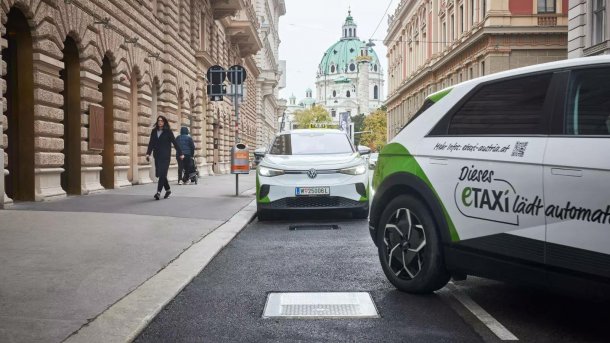Siphoning off electricity: matrix charging is cheaper than induction
A conductive connection system should make it cheaper to automate the charging of electric cars than with inductive alternatives.

Conductive charging is intended to be a way of charging electric cars more cheaply and automatically.
(Bild: Easelink)
- Clemens Gleich
Charging management will be an important feature of future vehicle fleets. Electric vehicles should be able to charge largely automatically in their own parking spaces, at cab ranks or in automated parking garages. There are various approaches to this. Some robotics experts are testing robotic arms that plug a normal charging cable into the car's charging socket, guided by a camera. However, this is relatively expensive and prone to errors because, for example, the opening of the charging flap is not standardized. How is the robot supposed to know how to open it? Even humans often have to fumble around when changing brands. The technically elegant solution is called induction: coils in the floor transfer energy to coils in the vehicle. However, this solution requires a comparatively large amount of copper and space on the vehicle. This drives up the costs.
The company Easelink from Graz in Austria wants to beat induction in terms of cost, weight and installation space on the vehicle with its "Matrix Charging" and match it in terms of convenience. The solution relies on conduction, i.e. conductive contacts. The output is up to 22 kW AC or 50 kW DC and can be transmitted in both directions. A fleet of vehicles equipped in this way can thus provide balancing energy. Easelink has benchmarked the costs at around a third of a functionally equivalent induction solution. The cost advantage is mainly because the conductive solution requires neither expensive coils nor additional power electronics. There is a further (small) cost advantage in operation due to the significantly lower transmission losses compared to induction.
OEM vs. Nachrüstung (2 Bilder)

(Bild: Easelink)
Matrix on the ground
The system's eponymous matrix consists of round contacts on a pad that either lies on the ground (garage, company parking lots) or is embedded flush in the ground (public roads with mixed road users). A small box is installed on the floor of the vehicle. When driving off, an ultra-wideband radio system from semiconductor manufacturer NXP helps to position the vehicle via the contact plate. In the case of a human driver, the system displays arrows, but the data could also be sent to an automatic parking system.
If the position and the other vehicle parameters (e.g. ready to drive off) are correct, a flap in the small box on the vehicle floor opens and a bellows trunk lowers onto the charging plate with a slight twist. Small wipers clean any dirt from the contacts. Magnets lock the trunk in the correct position. Now the data exchange takes place, for example via plug and charge according to ISO 15118. After successful negotiations, the plate switches the used power contacts under voltage and charging begins.
As the current enters the same way as with the plug, it runs via the existing onboard charger. In the retrofit solution, a distributor is used for the two connections of the charging socket and matrix charger, which safely separates the two systems electrically. For the original equipment, the onboard charger should accommodate both cables, in principle like a second charging socket on the vehicle.
Safety features
The bellows ensure primary contact protection for the power contacts. However, Easelink has also thought about the case where someone crawls under the car and pushes the bellows away. This does not have to be a human, but could be done by an interested marten or a domestic cat, for example. The geometry of the matrix is such that the protective conductor always has the first and last contact. The data contacts connect last, and this is where the contact breaks first in the event of movement. The power conductors are then de-energized in less than 100 ms. This is also similar to the design of the type 2 plug. Easelink has been awarded ASIL B certification for the connection box on the vehicle, which is the same class as the onboard charger on electric cars according to the ISO 26262 standard.
Anwendungen Matrix Charging (6 Bilder)

(Bild: Easelink)
In addition to wiping, the trunk can also blow to remove standing water from the contacts, for example. According to Easelink, the system can cope with most dirt on the road, especially standing salt water in winter. The plate contains a heating wire to prevent ice from forming. In terms of maintenance, it should be sufficient to subject the system to a visual and functional check as part of regular vehicle maintenance. Otherwise, it cleans itself.
According to Easelink, car models with the system as original equipment are planned for 2027/2028. The retrofit system will initially only be available for projects such as cab fleets. There are no official prices yet for either retrofitting or original equipment, only the announcement of the significant price advantage over induction. Perhaps this will motivate the manufacturers of inductive systems to respond to this challenge.
More about electric cars
ICCT Global Automaker Rating 2023: The fastest on the road to e-mobility
E-Cars: Germany plans mandatory charging points for gas stations
Electric and hybrid cars: only less than 40 % battery charge on Greek ferries
Up to 100 per cent duty for e-cars from China in the USA
E-cars: BMW admits to environmental problems at Moroccan cobalt mine
(cgl)